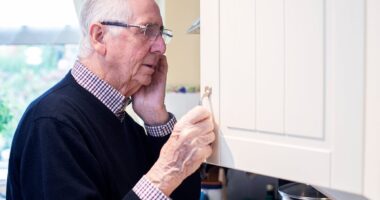A Massachusetts woman was diagnosed with a rare cancer after a routine visit to her eye doctor.
Eleanor Levine, who was 26 at the time, was being tested to see if she needed reading glasses when doctors found a large tumor on her retina.
‘At first, I was in a full-on panic,’ she said. ‘I don’t even wear glasses regularly. I figured that my reading glass prescription just needed a slight update.’
‘I didn’t notice any symptoms.’
Ms Levine’s case is just one of many in a mysterious rise of cancer in young people, namely diseases like colon and appendix cancer.

Eleanor Levine, 26 at the time, was diagnosed with ocular melanoma after visiting her eye doctor for routine testing

Ocular melanoma affects just five or six out of every one million Americans. It forms from melanocytes, which give color to the skin and eyes
She was diagnosed with ocular melanoma, a type of cancer that develops from melanocytes, cells that produce melanin – a pigment that gives skin, hair, and eyes their color.
While melanoma usually affects the skin, appearing as brown moles, melanocytes can also be found in the eyes.
Ocular melanoma can affect any part of the eye, though it’s most commonly found in the eyeball’s middle layer, the uvea, which contains the colored part of the eye known as the iris.
Symptoms include a change in shape or size of the pupil, changes in the eyeball’s position or movements, bulging eyes, dark spots on the iris, flashing lights in your field of vision, and blurry vision.
Ms Levine’s symptoms were so subtle that she didn’t notice until meeting with her doctor. ‘I had some vision loss peripherally in my left eye, and I was having some left-sided headaches,’ she said.
‘Before this, I didn’t notice any symptoms at all.’
Though nearly 100,000 Americans are diagnosed with melanoma every year, according to the American Cancer Society (ACS), ocular melanoma is much more rare.

Doctors found a large tumor in Ms Levine’s left eye, which has caused her to lose about half of her vision

Ms Levine’s current scans show no sign of cancer, though she will have to continue treatment for five years to slow vision loss
According to the American Society of Clinical Oncology (ASCO), about 3,500 adults in the US were diagnosed with the disease in 2023. The estimated incidence is about five to six per every one million people.
Though people who are white or have lightly colored eyes are at a greater risk of ocular melanoma, doctors aren’t sure what caused Ms Levine’s case.
‘In some ways, it also felt like a cruel joke from the universe; I had always been a worrier and a hypochondriac with an irrational fear of cancer,’ she said.
‘There’s nothing that I did or was exposed to that caused this. For whatever reason, this makes it all harder to grapple with. Why did this happen to me?’
‘I would wake up in the morning and think it was all a dream.’
‘Those were the darkest moments. It felt like looking down a black tunnel.’
In November 2022, doctors began treating Ms Levine with proton beam therapy. This is a type of radiation that uses molecules called protons instead of X-rays. The goal is to target tumors more directly without damaging surrounding tissues.
Since starting treatment, Ms Levine’s scans show no sign of cancer. However, she will need to continue treatment for five years, which includes receiving eye injections to slow and prevent further vision loss.
So far, she has lost about half of the vision in her left eye.
Ms Levine’s case is just one of many in a mysterious rise of cancers in young people. For example, doctors have warned that colon cancer deaths in people under 40 are expected to double by 2030.
Additionally, rates of appendix cancer have risen more than 200 percent in the last two decades.
‘I still have hard moments and nights when I cry myself to sleep, afraid of what the future holds,’ Ms Levine said. ‘Sometimes I’m angry, furious even, that this has happened to me.’
‘Being a young person with cancer has been very alienating, especially with a rare cancer pretty much no one has ever heard of.’
However, she also noted that the experience has made her more grateful and reminded her not to take anything for granted.
‘It’s a lesson in staying present, staying in the now,’ she said.
‘The hardest obstacle to overcome is the shattering of a false belief that my future was somehow predictable.’
‘I think most people (especially young people) convince themselves of this, but it’s not true.’
‘We have no idea what could happen to us, good or bad, and it’s just more clear to me now than ever.’








